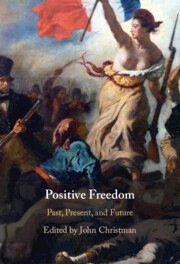Book contents
- Positive Freedom
- Positive Freedom
- Copyright page
- Contents
- Contributors
- Acknowledgments
- Introduction The Multiple Dimensions of Positive Freedom
- Chapter 1 Unity and Disunity in the Positive Tradition
- Chapter 2 Positive Liberty as Realizing the Essence of Man
- Chapter 3 Moral and Personal Positive Freedom
- Chapter 4 Positive Freedom and Freedom of Contract
- Chapter 5 Recognition and Positive Freedom
- Chapter 6 Self-Mastery and the Quality of a Life
- Chapter 7 Basic Freedom in the Real World
- Chapter 8 Reframing Democracy with Positive Freedom
- Chapter 9 Disability and Positive Liberty
- Chapter 10 Positive Freedom and Paternalism
- Chapter 11 Beyond Positive and Negative Liberty
- Chapter 12 Property and Political Power
- Chapter 13 Public Reason, Positive Liberty, and Legitimacy
- Works Cited
- Index
Chapter 9 - Disability and Positive Liberty
Published online by Cambridge University Press: 03 September 2021
- Positive Freedom
- Positive Freedom
- Copyright page
- Contents
- Contributors
- Acknowledgments
- Introduction The Multiple Dimensions of Positive Freedom
- Chapter 1 Unity and Disunity in the Positive Tradition
- Chapter 2 Positive Liberty as Realizing the Essence of Man
- Chapter 3 Moral and Personal Positive Freedom
- Chapter 4 Positive Freedom and Freedom of Contract
- Chapter 5 Recognition and Positive Freedom
- Chapter 6 Self-Mastery and the Quality of a Life
- Chapter 7 Basic Freedom in the Real World
- Chapter 8 Reframing Democracy with Positive Freedom
- Chapter 9 Disability and Positive Liberty
- Chapter 10 Positive Freedom and Paternalism
- Chapter 11 Beyond Positive and Negative Liberty
- Chapter 12 Property and Political Power
- Chapter 13 Public Reason, Positive Liberty, and Legitimacy
- Works Cited
- Index
Summary
Whereas Isaiah Berlin argued that positive liberty is not a theory of liberty at all, and that negative liberty is the only true conception of liberty, Dorothy Roberts argues that positive liberty is the only true conception of liberty, and that negative liberty is not a theory of liberty at all but rather a theory of power and privilege. This essay takes up that contrast with specific reference to disability. One could argue that disability takes a negative liberty view, because disabled persons are constrained by physical, legal, and attitudinal barriers from doing many things they want. But this requires a positive liberty gesture of expanding what we mean by “barriers,” such as seeing stairs as a barrier rather than a natural part of building architecture for which nobody is responsible. But this essay carries the positive liberty argument further, drawing on feminist insights about the social construction of desire and subjectivity, to argue that positive liberty is important to a full understanding of freedom for disabled persons.
- Type
- Chapter
- Information
- Positive FreedomPast, Present, and Future, pp. 155 - 173Publisher: Cambridge University PressPrint publication year: 2021

